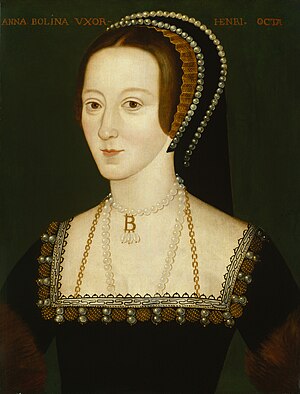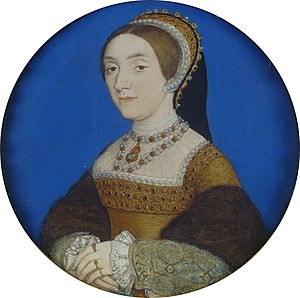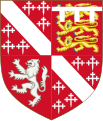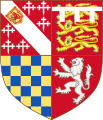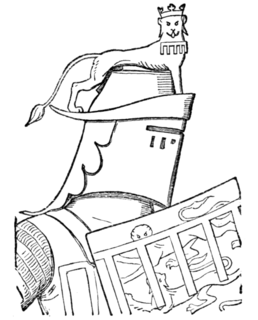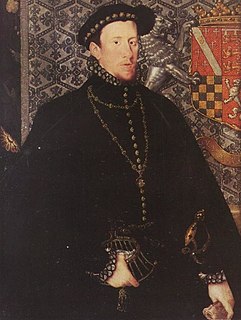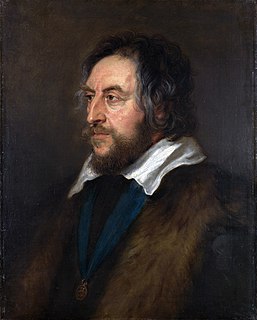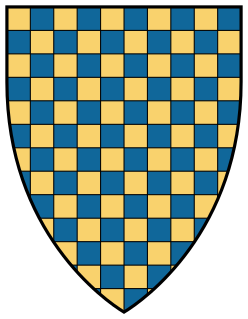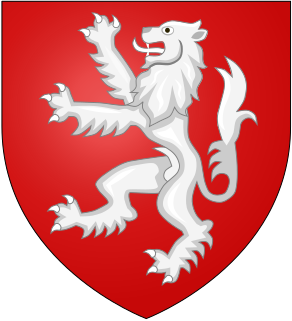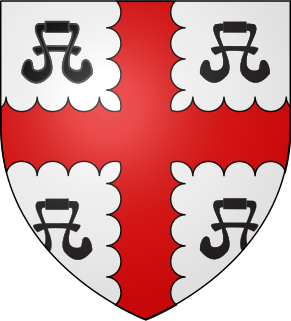| | | | Eleanor
of Castile
1241–1290 | | Edward I
Longshanks
King of England
1239–1307
r.1272–1307 | | Margaret
of France
1279–1318 | | | | | | | | | | | | | | | | | | | | |
| | | |
| | | | | | | | | | | | | | | | | | | | | | | | | | | | | | | | | | | | | | |
| | | | | | | | | | |
Edward II
King of England
1284–1327
r.1307–1327 | | | | | | | | | | Thomas
of Brotherton
Earl of Norfolk
1300–1338
r.1312–1338 | | Alice
Hayles | | | | | | | | | | | | | | | | |
| |
| | | | | | | | | | | | | | | | | | | | | | | | | | | | | | | | | | | | | | |
| | | | | | | | | | | | | | | | | | |
Edward III
King of England
1312–1377
r. 1327–1377 | | John
de Mowbray
Baron Mowbray
1310–1361
r.1321–1361 | | John
Segrave
Baron Segrave
1315–1353 | | Margaret
Css. of Norfolk
~1320–1399
r.1338–1399 | | Walter
Manny
Baron Manny
~1310–1372
r.1347–1372 | | Edward
of Norfolk
~1320–1334 | | Beatrice
de Mortimer
~1322-1383 | | Alice
of Norfolk
~1324–~1352 | | Edward
Montagu
Baron Montagu
?-1361 |
| | | | | |
| | | | | | | | | | | | | | | | | | | | | | | | | | | | | | | | | | | | | | | | | |
| | | | | | | | | | | | | | | | | |
| | | | | | | | | | | | | | | | | | | | | | | | | | | | | | | | | | | | | | | | | |
| | | | | | | | | | | | | | |
Edmund
of Langley
Duke of York
1341–1402
r.1385–1402 | | Blanche
Mowbray
~1342-1409 | | John
de Segrave
?-bef.1353 | | Elizabeth
Segrave
1338-1368 | | John
Mowbray
Baron Mowbray
1340–1368
r. 1361–1368 | | Thomas
Manny
1357-1362 | | Anne
Hastings
Baroness Manny
1355–1384
r.1375–1384 | | John
Hastings
Earl of Pembroke
1347 – 1375
r.1348–1375 | | | | |
| | | |
| | | | | | | | | | | | | | | | | | | | | | | | | | | | | | | | | | | | | | |
| | | | | | | | | | | | | | | | | | |
Richard
of Conisburgh
Earl of
Cambridge
~1375–1415 | | Elizabeth
le Strange
~1373–1383 | | Thomas
de Mowbray
Duke of Norfolk
1366–1399
r.1397—1399 | | Elizabeth
Fitzalan
1366–1425 | | Eleanor
de Mowbray
bef.1361
–bef.1417 | | John
de Welles
Baron Welles
1352–1421
r.1361–1421 | | John
de Mowbray
Earl of
Nottingham
1365-1383
r.1377—1383 | | | | | | | | |
| | | |
| | | | | | | | | | | | | | | | | | | | | | | | | | | | | | | | | | | | | | |
| | | | | | | | | | | | | | | | | | | | | | | | | | | |
Richard
Duke of York
1411–1460
r.1425–1460 | | Thomas
de Mowbray
Earl of Norfolk
1385–1405
r.1399–1405 | | John
de Mowbray
Duke of Norfolk
1392—1432
r.1397—1399 | | Katherine
Neville
~1400–aft.1483 | | Elizabeth
de Mowbray | | Michael
de la Pole
Earl of Suffolk
1394–1415
r.1415 | | Robert
Howard
of Tendring
1398–1436 | | Margaret
de Mowbray
1391-1459 | | John
Grey
of Ruthin |
| | | | | |
| | | | | | | | | | | | | | | | | | | | | | | | | | | | | | | | | | | | | | | | |
| | | | | | | | | | | | | |
| | | | | Eleanor
Bourchier
| | John
Mowbray
Duke of Norfolk
1415–1461
r.1432–1461 | | | | | | Edward
Neville
Baron
Bergavenny
bef.1414–1476
r.1447–1476 | | Katherine
Howard
1430-1480 | | Catherine
Moleyns
?-1465 | | John
Howard
Duke of Norfolk
~1425–1485
r.1483–1485 | | Margaret
Chedworth
1436–1494 |
| | | | | | |
| | | | | | | | | | | | | | | | | | | | | | | | | | | | | | | | | | | | | | | | | |
| | | | | | | | | | | | | | | | | | | |
Edward IV
King of England
1442–1483
r.1461–1470
1471–1483 | | Elizabeth
Talbot
~1442–~1506 | | John
de Mowbray
Duke of Norfolk
1444–1476
r.1461–1476 | | Robert
Mortimer
of Landmere
?-1485 | | Elizabeth
Howard | | Anne
Howard
1446–1474 | | Edmund
Gorges
of Wraxall
~1454-1512 | | | Katherine
Howard
?-1536 | | John
Bourchier
Baron Berners
1467–1533
r.1474–1533 |
| | | | |
| | | | | | | | | | | | | | | | | | | | | | | | | | | | | | | | | | | | | | | | | |
| | | | | | | | | | | | | | | | | | | | | | | | | | |
| | | | | Richard
of Shrewsbury
Duke of York
1473-? | | Anne
de Mowbray
Css of Norfolk
1472–~1481 | | Elizabeth
Tilney
Css of Surrey
bef.1445–1497 | | Thomas
Howard
Duke of Norfolk
1443–1524
r.1514–1524 | | Agnes
Tilney
~1477–1545 | | Margaret
Howard
1445–1484 | | John
Wyndham
of Crownthorpe
and Felbrigg
1451-1503 | | Jane
Howard
1450-1508 |
| | | | | |
| | | | | | | | | | | | | | | | | | | | | | | | | | | | | | | | | | | | | | | | |
| | | | | | | | | | | | | | | | | | | | | | | | | | | | | |
| | | | | Edward
Howard
~1476–1513 | | John
Howard
1482-1502 | | Henry
~1480-
bef.1513 | | | Richard
Howard
1487-1517 | | | Elizabeth
Howard
?-1536 | | Katherine
Broughton | | William
Earl of
Effingham
1510–1573
r.1554–1573 | | Margaret
Gamage
1515-1581 |
| | |
| | | | | | | | | | | | | | | | | | | | | | | | | | | | | | | | | | | | | | | | | | |
| | | | | | | | | | | | | | | | | | | | | | |
| | | | | John Grey
Viscount
Lisle
?-1504 | | Muriel
Howard
?-1512 | | Charles
Howard
1483-1512 | | | Thomas
Howard
1511–1537 | | Dorothy
Howard
~1511-1580 | | Anne
Howard
~1518-1558 | | John
de Vere
Earl of Oxford
1499–1526
r.1513–1526 | | Earls of
Effingham |
| |
| | | | | | | | | | | | | | | | | | | | | | | | | | | | | | | | | | | | | | |
| | | | | | | | | | | | | | | | | | |
Anne
of York
1475–1511 | | Thomas
Howard
Duke of Norfolk
1473–1554 | | Elizabeth
Stafford
1497–1558 | | Edmund
Howard
1478–1539 | | Joyce
Culpeper
~1480–~1528 | | Elizabeth
Howard
~1480–1538 | | Thomas
Boleyn
Earl of Wiltshire
1477–1539
r.1529–1539 | | | | | | | | |
| | | | | | |
| | | | | | | | | | | | | | | | | | | | | | | | | | | | | | | | | | | | | | | |
| | | | | |
Elizabeth
Marney
?-1517 | | | | | | | | | | | | | | | | Catherine
Howard
1518/1524
–1542 | | Henry VIII
King of England
1491–1547
r.1509–1547 | | Anne
Boleyn
1501/1507
–1536 | | | | | | | | |
| | |
| | | | | | | | | | | | | | | | | | | | | | | | | | | | | | | | | | | | | | | |
| | | | | | | | | | | | | | | | | | | | | | | |
Gertrude
Lyte | | | Thomas
Viscount
of Bindon
1520–1582
r.1559–1582 | | Mabel
Burton | | Henry
Howard
Earl of Surrey
1516/1517–
1547 | | Frances
de Vere
1517–1577 | | Henry
Duke of
Richmond
and Somerset
1519–1536 | | Mary
Howard
1519–1557 | | | | | | | | |
| | | | |
| | | | | | | | | | | | | | | | | | | | | | | | | | | | | | | | | | | | | |
| | | | | | | | | | | | | | | | | | | | | | | | |
| | | | Henry
Howard
Earl of
Northampton
1540–1614
r.1604–1614 | | Jane
Howard
1533/37
–1593 | | Charles
Neville
Earl of
Westmorland
1542–1601
r.1564–1571 | | | Margaret
Howard
1543-1591 | | Henry
Scrope
Baron Scrope
of Bolton
1534–1592
r.1549–1592 | | Katherine
Howard
1538-1596 | | Henry
Berkeley
Baron
Berkeley
1534–1613 | | | | |
| | |
| | | | | | | | | | | | | | | | | | | | | | | | | | | | | | | | | | | | | | |
| | | | | | | | | | | |
Robert
Sackville
Earl of Dorset
1561–1609
r.1608–1609 | | | | | | | Mary
FitzAlan
1540–1557 | | Thomas
Howard
Duke of Norfolk
1536–1572
r.1554–1572 | | | | | | | Margaret
Audley
1540–1564 | | | Elizabeth
Leyburne
1536–1567 | | Thomas
Dacre
Baron Dacre
1527–1566
r. 1563–1566 | | | | |
| | | | | | | | | | | |
| | | | | | | | | | | | | | | | | | | | | | | | | | | | | | | | | | | | | | | | | |
| | | | | | | | | | | | | | | | | | | | | | | | | | | |
| | | | | | | | | | | | | | | | | | | | | | | | | | | | | | | | | | | | | | | | | | |
| | | | | | | | | | | | | | | | | | | | | | | | | | | | | | | | | | | |
Margaret
Sackville
1562–1591 | | | Elizabeth
Howard
1559-1591 | | Philip
Howard
Earl of Arundel
1557–1595
r.1580–1595 | | Anne
Dacre
1557–1630 | | Mary
Dacre
1563-1578 | | Thomas
Howard
Earl of Suffolk
1561–1626
r.1603–1626 | | Catherine
Howard
1564–1638 | | William
Howard
1563–1640 | | Elizabeth
Dacre
1564-1639 |
| | | | | |
| | | | | | | | | | | | | | | | | | | | | | | | | | | | | | | | | | | | |
| | | |
| | | | | | | | Thomas
Howard
Earl of Arundel
1586–1646
r.1604–1646 | | Alethea
Talbot
1585–1654 | | | | | | | | | | | | | | | | | | | | |
| |
| | | | | | | | | | | | | | | | | | | | | | | | | | | | | | | | | | | | | |
| | | | | | | | | | | | | | | | | | | |
| | | | | | | | James
Howard
Baron
Maltravers
1607–1624 | | Henry
Howard
Earl of Arundel
1608–1652
1646–1652 | | Elizabeth
Stuart
1610-1673 | | Anne
Howard
1612–1658 | | William
Howard
Viscount
Stafford
1614–1680 | | Mary
Stafford
1616-1692 | | | | |
| | |
| | | | | | | | | | | | | | | | | | | | | | | | | | | | | | | | | | | | | |
| | | | | | | | | | | | | | | | | | | | | | | | | | | | | | | | | | | |
Philip
Howard
1629–1694 | | Anne
Howard
1632–? | | Catherine
Howard
1634–1655 | | Talbot
Howard
1636–? | | | Edward
Howard
1637–1691 | | Anne
Wilbraham
~1655-? | | Francis
Howard
1640–1683 | | Elizabeth
Howard
1651–1705 | | | | |
|
| | | | | | | | | | | | | | | | | | | | | | | | | | | | | | | | | | | | | |
| | | | | | | | | | | | | | | | | | | | | | | | | | | |
| | | | Thomas
Howard
Duke of Norfolk
1627–1677
r.1660–1677 | | Anne
Somerset
1631-1662 | | Henry
Howard
Duke of Norfolk
1628–1684
r.1677–1684 | | Jane
Bickerton
1643-1693 | | Charles
Howard
of Greystoke
1630–1713 | | Mary
Tattershall
?-1695 | | Bernard
Howard
of Glossop
1641–1717 | | Catherine
Tattershall
?-1727 |
| | | | | | |
| | | | | | | | | | | | | | | | | | | | | | | | | | | | | | | | | | | | | | | | | |
| | | | | | | | | | | | | |
| | | | Mary
Mordaunt
1659–1705 | | Henry
Howard
Duke of Norfolk
1655–1701
r.1684–1701 | | Thomas
Howard
of Worksop
1662-1689 | | Mary
Elizabeth
Savile
~1663-1732 | | Henry
Howard
of Greystoke
~1668–1720 | | Mary
Aylward
~1670–1747 | | Bernard
Howard II
of Glossop
1674-1735 | | Anne
Roper
?-1744 |
| | | | | | |
| | | | | | | | | | | | | | | | | | | | | | | | | | | | | | | | | | | | | | | | |
| | | | | | | | | | | | | | | | | | | | |
Maria
Shireburn
~1693-1754 | | Thomas
Howard
Duke of Norfolk
1683–1732
r.1701–1732 | | Walter
Aston
Lord of Forfar
1660–1748 | | Mary
Howard
?-1723 | | | | | | | Charles
Howard
Duke of Norfolk
1720–1786
r.1777–1786 | | Catherine
Brockholes
bef.1724–1784 | | Henry
Howard
of Glossop
1713-1787 | | Juliana
Molyneux
?-1808 |
| | | | | |
| | | | | | | | | | | | | | | | | | | | | | | | | | | | | | | | | | | | | | | | |
| | | | | | | | | | | | | | | | | | | | | | | | |
Mary
Blount
1712–1773 | | Edward
Howard
Duke of Norfolk
1686–1777
r.1732–1777 | | Philip
Howard
~1687-1750 | | Marion
Coppinger
?-1768 | | Charles
Howard
Duke of Norfolk
1746–1815
r.1786–1815 | | Frances
Scudamore
~1750-1820 | | Elizabeth
Maycock
?-1811 | | Edward
Charles
Howard
1774-1816 | | | | | |
| | | |
| | | | | | | | | | | | | | | | | | | | | | | | | | | | | | | | | | | | | |
| | | | |
| | | | | | | | | | | | | | | | | | | | | | | | | | | | | | | | | | | | | |
| | | | | | | | | | | | | | | | | | | | | | | | | | | |
| | | | Elizabeth
Belasyse
1770–1819 | | Bernard
Howard
Duke of Norfolk
1765–1842
r.1815–1842 | | Anne
Howard
1742–1787 | | Robert
Petre
Baron Petre
1742–1801
r.1742–1801 | | Juliana
Barbara
Howard
1769-1833 | | | Mary
Bridget
1767-1843 | | Henry
Thomas
1766-1842 | | Elizabeth
Long |
| | | | | | | |
| | | | | | | | | | | | | | | | | | | | | | | | | | | | | | | | | | | | | | | |
| | | | | | |
| | | | Henry
Howard
Duke of Norfolk
1791–1856
r.1842 – 1856 | | Charlotte
Leveson
-Gower
1788–1870 | | | | | | Robert Petre
Baron Petre
1763–1809
r.1801–1809 | | | | | | | | | | | | | | | | | |
| | | | | | |
| | | | | | | | | | | | | | | | | | | | | | | | | | | | | | | | | | | | | |
| | | | | | |
| | | | Bernard
Thomas
Fitzalan
-Howard
1825–1846 | | | Mary
Charlotte
Howard
1822–1897 | | Thomas
Foley
Baron Foley
1808–1869
r.1833–1869 | | | | | | | | | | | | | | | | | | | | |
|
| | | | | | | | | | | | | | | | | | | | | | | | | | | | | | | | | | | | | |
| | | | | | | | | | | | | | | | | | |
Winifred
Mary
De Lisle
?-1909 | | Edward
Fitzalan-H.
Baron of
Glossop
1818–1883
r.1869–1883 | | Augusta
Talbot
?-1862 | | George
Manners
1820–1874 | | Adeliza
Fitzalan
-Howard
?-1904 | | Henry
Fitzalan
-Howard
Duke of Norfolk
1815–1860
r.1856–1860 | | Augusta
Lyons
1821–1886 | | | | | | | | |
| | | | | |
| | | | | | | | | | | | | | | | | | | | | | | | | | | | | | | | | | | | | | | | |
| | | | | | | | | | | | | | | | | | | | | | | | | | | | | | | |
Charles
Rawdon-H.
Earl of
Loudoun
1855–1920
r.1874–1920 | | Alice
Elizabeth
Fitzalan-H.
1856-1915 | | | Constance
Mary
Germana
Fitzalan-H.
?-1933 | | Charles
Lennox
Tredcroft
1832-1917 | | Charles
Bernard
Talbot
Fitzalan-H.
1852–1861 | | Minna
Charlotte
Fitzalan-H.
1843-1921 | | | Victoria
Alexandrina
Fitzalan-H.
1840-1870 | | James
Hope
-Scott
1812–1873 | | Mary
Adeliza
Fitzalan-H.
1845-1925 |
| | |
| | | | | | | | | | | | | | | | | | | | | | | | | | | | | | | | | | | | | | | | |
| | | | | | | | | | | | | | | | | | | | | | | | | | | |
William
Middleton | | Winifrede
Mary
Fitzalan-H.
?-1937 | | | Gwendolen
Mary Anne
Fitzalan-H.
1854–1932 | | John
Crichton-S.
Marquess
of Bute
1847–1900
r.1848–1900 | | Elizabeth
Mary
Fitzalan-H.
1859-1859 | | Etheldreda
Fitzalan-H.
1849-1926 | | | Philippa
Fitzalan-H.
1852–1946 | | Edward
Stewart
1857-1948 | | Philip
Thomas
Fitzalan-H.
1853-1855 |
| | |
| | | | | | | | | | | | | | | | | | | | | | | | | | | | | | | | | | | | | | | |
| | | | | | | | | | | | | | | | | | | | | | | | | |
Hyacinthe
Scott-Kerr
1865-1930 | | Francis
Edward
Fitzalan-H.
Baron of
Glossop
1859–1924 | | | | | | Clara
Louisa
Greenwood
1852-1887 | | Angela
Mary
Charlotte
Fitzalan-H.
?-1919 | | Marmaduke
Constable-M.
Lord Herries
of Terregles
1837–1908
r.1876–1908 | | | Anne
Fitzalan-H.
1857-1931 | | Ralph
Drury
Kerr
1837–1916 | | Margaret
Fitzalan-H.
1860-1899 |
| | | | | | | | | | |
| | | | | | | | | | | | | | | | | | | | | | | | | | | | | | | | | | | | | | | | | | |
| | | | | | | | | | | | | | | | | | | |
George
Greaves
1889-1953 | | Frances
Alice
Fitzalan-H.
1892-? | | | | | | | | | | | | Gwendolen
Constable-M.
1877–1945 | | Henry
Fitzalan-H.
Duke of Norfolk
1847–1917
r.1860–1917 | | Flora
Abney
-Hastings
1854–1887 | | Edmund
Vcte. FitzAlan
of Derwent
1855–1947
r.1921–1947 | | Mary
Bertie
1859–1938 |
| | | | | |
| | | | | | | | | | | | | | | | | | | | | | | | | | | | | | | | | | | | | | | |
| | | | | | | | | | |
| | | | | | | | | | | | | | | | | | | | | | | | | | | | | | | | | | | | | | | | | |
| | | | | | | | | | | | | | | | | | | |
Gladys
Norton | | Philip
Granville
James
Fitzalan-H.
1895-1918 | | Bernard
Fitzalan-H.
Baron
of Glossop
1885–1972 | | Mona
Stapleton
Baroness
Beaumont
1894–1971 | | Muriel
Augusta
Mary
Fitzalan-H.
1884-1962 | | | Colin
Keppel
Davidson
1895-1943 | | Rachel
Pepys
1905–1992 | | Anthony
Hilton
Pepys | | Philip
Joseph
Earl of Surrey
1879–1902 |
| | | | |
| | | | | | | | | | | | | | | | | | | | | | | | | | | | | | | | | | | | | | | |
| | | | | | | | | | | | | | | | | | | | | | | | | | | |
Michael
Fitzalan-H.
1916-2007 | | Mariegold
Magdalane
Fitzalan-H.
1919-2006 | | Gerald
James
Jamieson
?-1992 | | | Martin
Fitzalan-H.
1922-2003 | | Bridget
Anne
Keppel
1925-2011 | | | Winifred
Alice
Fitzalan-H.
1914–2006 | | John
Edward
Broke
Freeman | | Katherine
Mary
Fitzalan-H.
1912–2000 | | Joseph
Anthony
Moore
Phillips
1914-1990 |
| | | |
| | | | | | | | | | | | | | | | | | | | | | | | | | | | | | | | | | | | | | | |
| | | | | | | | | |
| | | | Theodore
Bernard
Peregrine
Hubbard
1923-2012 | | Miriam
Fitzalan-H.
1924-1996 | | | Miranda
Fitzalan-H.
1927- | | Christopher
Anthony
Emmett
1925-? | | Bernard
Fitzalan-H.
Duke of Norfolk
1908–1975
r.1917–1975 | | Lavinia
Strutt
1916–1995 | | | | | | | | |
| | | |
| | | | | | | | | | | | | | | | | | | | | | | | | | | | | | | | | | | | | | | |
| | | | | | | | | | |
| | | | Bernard
Noel
Kelly
1930- | | Mirabel
Fitzalan-H.
1931-2008 | | | | | | | Colin
Cowdrey
Baron of
Tonbridge
1932–2000 | | Anne
Lady Herries
of Terregles
1938–2014
r.1975–2014 | | | Mary
Lady Herries
of Terregles
1940–2017
r.2014–2017 | | Anthony
Mumford
1936–2006 | | | | |
| | |
| | | | | | | | | | | | | | | | | | | | | | | | | | | | | | | | | | | | | | | |
| | | | | | | | | | | | | | |
Anne
Constable
-Maxwell
1927–2013 | | Miles
Fitzalan-H.
Duke of Norfolk
1915-2002
r.1975–2002 | | Mark
Fitzalan-H.
1934- | | Jacynth
Lindsay
1934- | | Nigel
Clutton | | Sarah
Margaret
Fitzalan-H.
1941–2015 | | Theresa
Lady Herries
of Terregles
1945-
r.2017- | | Michael
Ancram
Marquess
of Lothian
1945- | | | | |
| | | | |
| | | | | | | | | | | | | | | | | | | | | | | | | | | | | | | | | | | | |
| | | | | | | | | | | | | | | | | | | | | | | | |
| | | | | Tessa Mary
Isabel
Fitzalan-H.
1950- | | Roderick
Balfour
Earl of
Balfour
1948-
r.2003- | | Carina
Mary
Gabrielle
Fitzalan-H.
1952- | | David
Frost
1939–2013 | | Patrick
Ryecart
1952- | | Marcia
Mary
Josephine
Fitzalan-H.
1953- | | Nick
George | | | | |
| | | |
| | | | | | | | | | | | | | | | | | | | | | | | | | | | | | | | | | | | |
| | | | | | | | | | | |
| | | | Edward
Fitzalan-H.
Duke of Norfolk
1956-
r.2002– | | Georgina
Susan
Gore
1962- | | Gerald
Bernard
Fitzalan-H.
1962- | | Emma
Roberts | | | | | | | | | | | | | | | | |
| | |
| | | | | | | | | | | | | | | | | | | | | | | | | | | | | | | | | | | | | |
| | | | | | | | | | | | | | | | | | | | |
| | | | Henry Miles
Fitzalan
-Howard
Earl of Arundel
1987- | | Rachel
Fitzalan
-Howard
1989- | | Thomas
Fitzalan
-Howard
1992- | | Isabel
Fitzalan
-Howard
1994- | | Philip
Fitzalan
-Howard
1996- | | | | | | | | | | | | |
|
|
|


